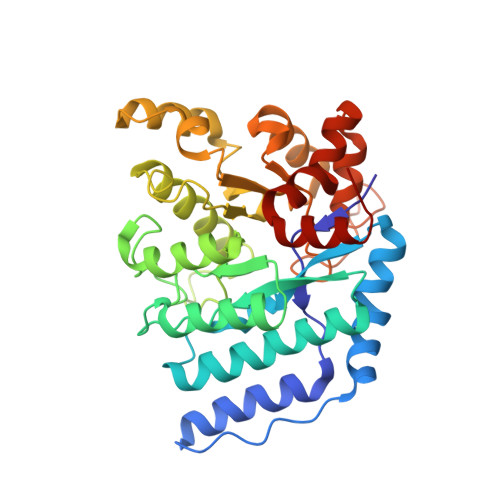Structure and Reaction Mechanism of the LigJ Hydratase: An Enzyme Critical for the Bacterial Degradation of Lignin in the Protocatechuate 4,5-Cleavage Pathway.
Hogancamp, T.N., Mabanglo, M.F., Raushel, F.M.(2018) Biochemistry 57: 5841-5850
- PubMed: 30207699
- DOI: https://doi.org/10.1021/acs.biochem.8b00713
- Primary Citation of Related Structures:
6DWV, 6DXQ, 6DXS - PubMed Abstract:
LigJ from the soil bacterium Sphingobium sp. SYK-6 catalyzes the reversible hydration of (3 Z)-2-keto-4-carboxy-3-hexenedioate (KCH) to 4-carboxy-4-hydroxy-2-oxoadipate (CHA) in the degradation of lignin in the protocatechuate 4,5-cleavage pathway. LigJ is a member of the amidohydrolase superfamily and an enzyme in cog2159. The three-dimensional crystal structure of wild-type LigJ was determined in the presence [Protein Data Bank (PDB) entry 6DXQ ] and absence of the product CHA (PDB entry 6DWV ). The protein folds as a distorted (β/α) 8 -barrel, and a single zinc ion is bound in the active site at the C-terminal end of the central β-barrel. The product CHA is ligated to the zinc ion in the active site via the displacement of a single water molecule from the coordination shell of the metal center in LigJ. The product-bound structure reveals that the enzyme catalyzes the hydration of KCH with the formation of a chiral center at C4 with S stereochemistry. The E284Q mutant was unable to catalyze the hydration of KCH to CHA, and the structure of this mutant was determined in the presence of the substrate KCH (PDB entry 6DXS ). On the basis of the structure of LigJ in the presence of KCH and CHA, it is proposed that the side chain carboxylate of Glu-284 functions as a general base in the abstraction of a proton from a bound water molecule for nucleophilic attack at C4 of the substrate. The reaction is facilitated by the delocalization of the negative charge to the metal center via the carbonyl group at C2 of the substrate. C3 of the substrate is subsequently protonated by Glu-284 functioning as a general acid. The overall reaction occurs by the syn addition of water to the double bond between C4 and C3 of the substrate KCH. The kinetic constants for the hydration of KCH to CHA by LigJ at pH 8.0 are 25 s -1 ( k cat ) and 2.6 × 10 6 M -1 s -1 ( k cat / K m ).
Organizational Affiliation:
Department of Chemistry , Texas A&M University , College Station , Texas 77843 , United States.
















